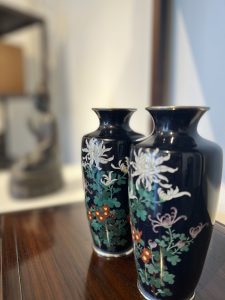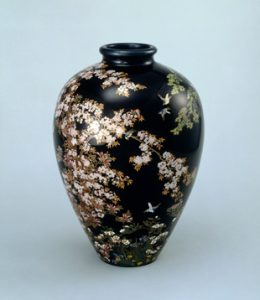帝室技芸員 並河靖之(愛知県名古屋市千種区姫池通 骨董買取 古美術風光舎)
2024.09.20
みなさまこんにちは、スタッフYでございます。
記録ってこんなにあっさり塗り替えられるのなんですね…。
たしか、昨日のブログにて大谷翔平選手の48ー49からの50-50が待ち遠しいというつぶやきをしたはずですが、今朝TVをつけたところ、あっさり記録が達成されているではないですか。朝から驚いたと共に、へ?もう?と思いながら、朝ご飯を食べた方もいらっしゃったのではないでしょうか笑。
今朝の試合は、19日(日本時間20日)、敵地でのマーリンズ戦にて「1番・DH」で先発出場。まずは2盗塁をあっさり決め、そのあとホームラン2本。50-50をあっさり達成したかと思うと、この試合だけで結果ホームラン3本、盗塁2盗塁により、すぐに51-51と記録をさらに伸ばし偉業達成であります!。
しかも3打席連発を含む6安打で球団新記録10打点ですから、この大暴れにスタジアムは騒然、歓声では終わらずパニック状態。もはや誰にもとめられないこの大暴れぶりをスタジアムで観戦できたファン方は本当に本当に羨ましい!。
そんな大興奮の試合に足を引っ張られながら出勤してまいりまいたが、たぶん今日は大谷選手のこの偉業達成のニュースで持ち切りだと思いますので、せめて夜は思う存分ザッピングしまくりたいと思っております。

というわけで、ここからは通常運転に戻っていきましょう。
本日はシリーズ化しております「帝室技芸員」なのですが、本日はちょっと気になった七宝作家の2人のナミカワについてお伝えしたいと思っております。
明治時代、七宝業界は尾張、京都を中心に数多くの七宝作家が存在しました。ここ愛知県尾張地方でも七宝焼の生産は盛んでして、現在でも生産がされております。当時多くの七宝作家がおりましたが、その中でたった二人だけ帝室技芸員に任命された作家が、今日ご紹介する京都の並河靖之[1845〜1927]と東京の濤川惣助[1847〜1910]の、二人のナミカワであります。
偶然にもほどがるのですが、二人は同じ「ナミカワ」姓であります。二人のナミカワは共に同世代に日本の近代七宝家を代表する人物として広く国内外に知られた人物であり、同じ【ナミカワ】姓なのですが、京の宮家の家従家に養子に入った並河靖之と、房総の農村の出である濤川惣助との間には何の繋がりなはないとのことです。
日本の七宝焼が海外へと広まっていった明治中頃に二人は日本を代表する七宝家になり、帝室技芸員にも任命されておりますが、明治期七宝焼が海外へと広まっていった時代ですので、ローマ字表記することもあったでしょう…。そうすると同じ「KAMIKAWA」。外国の方は混乱はしなかったのか、ちょっと気になるところであります。
本日は京都のナミカワ、並河靖之について述べていきますが、まずは略歴を。
【京都の七宝作家 並河靖之】
並河靖之 (1845~1927) は、 弘化2 (1845) 年武州川越藩京都留守居役京都詰め役人高岡九郎左衛門の三男として生まれました。 安政2 (1855) 年、十一歳の時に青蓮院の坊官をつとめていた並河家に養子となりました。 青蓮院宮に仕えましたが、 明治維新を迎えて社会体制の変革に伴い、 実業を志し 明治6(1873)年頃、 名古屋方面から来た七宝家について七宝の製造法を学びました。
明治8(1875)年の京都博覧会に七宝作品を出品して受賞したのを皮切りに数々の国内外の博覧会に出品して受賞し、 日本を代表する七宝家の地位を確立。特にその細かい植線による図柄の表現と、艶のある黒色透明釉薬の発明は日本の七宝を広く諸外国へ知らしめることに成功しました。 明治26 (1893) には、縁綬褒章を受章し、続いて明治29 (1896) 年には帝室技芸員に選ばれました。
並河靖之の作品の中でも特に有名なものとして、「七宝 四季花鳥図 花瓶」がありますが、この作品は、明治天皇の御下命により、1900年のパリ万国博覧会の出品用作品として制作されました。パリ万国博覧会では金牌を受賞しており、現在では並河靖之の代表作として【三の丸尚蔵館】に所蔵されています。

「七宝 四季花鳥図 花瓶 サクラ」 明治32年(1899)
七宝 径25.0×高36.0
(宮内庁HPより)
1対の作品でして、サクラと青もみじがあります。大きく配された山桜やモミジとともに数種の野鳥が、並河が創始した光沢をたたえた黒色釉の背景から鮮やかに浮かび上がっているかのようです。また、細密な図案は絵筆で描かれたかのように樹幹の輪郭となる金属線に肥痩がつけられており、図柄を拡大してみますと、その技術の高さと緻密さには目が奪われます。近代有線七宝の最高水準を示す並河の傑作として、内外での大きな評価を得ており、御下命により制作されて1900年パリ万国博覧会に出品された作品であります。
その並河靖之の作品のすぐれた特徴として、緻密な細工が挙げられます。それぞれの作品は、細部に至るまで手間暇をかけて作られており、その技術力は他の追随を許しません。また、作品にはよく自然の要素が含まれており、花、鳥、風景など、自然からインスピレーションを得て作られた作品が多く、それが彼の作品に深みと生命感を与えています。
また、並河靖之の作品は、彼の生涯を通じて幾度となく変化してきました。初期の作品は、伝統的な七宝の手法を活かした作品が多く、その後は次第に独自の色彩感やデザインを追求するようになっていきます。そして後期の作品では、より大胆な色彩と自由な形状を用いた作品が増え、彼自身の芸術観が色濃く表現されています。
そして、並河靖之は中原哲泉らとともに有線七宝を極めたことでも有名です。有線七宝とは、金属の胎(ボディ)に文様の輪郭線として金や銀の線をテープ状に貼りつけ、線の間に釉薬をさして焼成・研磨を繰り返す技法のことですが、パリやシカゴ、ロンドン、バルセロナの博覧会や内国勧業博覧会に出品した壺や花瓶などの作品は、その技術を存分に表現し、金賞を含む多数の賞を受賞し、国内外を問わず高い評価を受けました。
また、並河の七宝は、京都舎密局におけるドイツ人科学者のワグネルとの出会いや、自ら開発した黒色透明釉薬などによって作風が変化していきます。
どの時代の作品であれ、彼の作品の特徴は色彩と細部の表現の素晴らしさでしょう。また、独自の研究で黒色透明釉薬を開発や綿密な植線と優れた色彩感覚で有線七宝を極めた作品は、ただただため息であります。
次回はもう一人のカミカワ、東京の濤川惣助をご紹介していきたいと思います。
それではごきげんよう。
Hello everyone, this is Staff Y.
Records can be rewritten so easily….
I must have tweeted in yesterday’s blog that I was anxiously awaiting Shohei Otani’s 50-50 from 48-49, but when I turned on the TV this morning, I saw that the record had been easily broken! I was surprised this morning, and also thought, “What? Already? I guess some of you may have eaten your breakfast with the thought, “What?
This morning’s game was against the Marlins on the 19th (20th in Japan time), and he started as the “No. 1 DH. First, he easily stole two bases, then hit two home runs, and just when you thought he had easily achieved a 50-50 record, he hit three home runs and stole two bases in this game alone, and quickly improved his record further to 51-51!
Moreover, with six hits, including three in a row, he scored 10 runs, a new team record. The stadium was in a state of panic, not just cheering, as a result of this rampage. The fans who were able to watch this unparalleled rampage at the stadium were truly, truly envious!
I’ve been dragged to work by the excitement of the game, but I’m sure today’s news will be all about Otani’s accomplishment, so at least I’ll be zapping the news as much as I can at night.
So, let’s get back to our normal routine from here.
Today, I would like to tell you about two cloisonne enamel artists who caught my attention.
In the Meiji era, there were many cloisonne enamel artists in the cloisonne enamel industry, especially in Owari and Kyoto. Here in the Owari region of Aichi Prefecture, cloisonne enamel ware production also flourished and is still being produced today. Among the many cloisonne enamel ware artists of the time, only two were appointed as Imperial Artists: Namikawa Yasuyuki (1845-1927) of Kyoto and Tawokawa Sosuke (1847-1910) of Tokyo, the two artists introduced today.
It is not so much of a coincidence that they share the same surname, “Namikawa. Both Namikawa and Tawokawa were well known in Japan and abroad as representatives of modern Japanese cloisonne enamel ware in their generation, and although they share the same surname, there is no connection between Namikawa Yasuyuki, who was adopted by a member of the imperial family in Kyoto, and Tawokawa Sosuke, who came from a farming village in Boso.
In the middle of the Meiji period (1868-1912), when Japanese cloisonne enamel ware was spreading overseas, the two became Japan’s representative cloisonne enamel ware artists and were appointed as Imperial Household Artists. In that case, the name would have been the same, “KAMIKAWA. I am a little concerned that foreign people might have been confused.
Today, I would like to talk about Yasuyuki Namikawa, the “Namikawa of Kyoto,” but first, a brief biography.
Namikawa Yasuyuki, Kyoto’s Cloisonne Treasure Artist
Namikawa Yasuyuki (1845-1927) was born in 1845 as the third son of Takaoka Kurozaemon, an official of the Kawagoe clan in Bushu, Kyoto. In 1855, at the age of eleven, he was adopted into the Namikawa family, who served as a priest at Seiren-in Temple. He served Seiren-in Palace, but with the Meiji Restoration and changes in the social system, he decided to pursue business and learned how to make cloisonne enamel ware from a cloisonne enamel ware maker from the Nagoya area around 1873.
He exhibited cloisonne enamel works at the Kyoto Exposition in 1875 and won awards at numerous national and international expositions, establishing his position as one of Japan’s leading cloisonne enamel artists. In particular, his fine linework and the invention of a glossy black transparent glaze made Japanese cloisonne enamel ware widely known throughout the world. In 1893, he was awarded the Medal with Ribbon, and in 1896, he was selected as a member of the Imperial Household Artists.
One of Namikawa Yasuyuki’s most famous works is the “Cloisonne Vase with Flowers and Birds of the Four Seasons,” which was created by order of the Emperor Meiji to be exhibited at the Paris Exposition of 1900. It was awarded a gold medal at the Paris Exposition, and is now in the collection of the San-no-Maru Shogakukan as one of Namikawa Yasuyuki’s representative works.
Cloisonne enamel “Flower Vase with Seasonal Flowers and Birds, Cherry Blossom,” 1899
Cloisonne enamel, Diameter 25.0 x Height 36.0
(From the Imperial Household Agency website)
This pair of vases includes a cherry blossom and a blue maple tree. The large arrangement of mountain cherry blossoms and maples, along with several species of wild birds, seem to emerge vividly from the glossy black glazed background created by Namikawa. The detailed design is as if painted with a paintbrush, and the metal lines outlining the tree trunks are thickened and thinned. This work was produced by order of the Emperor of Japan and exhibited at the Paris World Exposition in 1900.
One of the outstanding characteristics of Namikawa Yasuyuki’s works is their meticulous craftsmanship. Each piece is made with painstaking care and attention to detail, and his technical skill is unrivaled. In addition, his works often contain elements of nature, and many of his pieces are inspired by nature, such as flowers, birds, and landscapes, which gives his pieces depth and life.
In addition, Yasuyuki Namikawa’s work has changed many times throughout his life. In his early works, many of his pieces utilized traditional cloisonne enamel techniques, after which he gradually began to pursue his own unique sense of color and design. And in his later works, more bold colors and freer shapes are used, and his own view of art is strongly expressed.
Namikawa Yasuyuki is also famous for his mastery of wired cloisonne enamel ware together with Tetsusen Nakahara and others. Wired cloisonne enamel ware is a technique in which gold or silver lines are taped to a metal body as outlines of patterns, and glaze is applied between the lines, and the firing and polishing processes are repeated. Namikawa’s cloisonne enamel works received numerous awards, including gold medals, and were highly acclaimed both in Japan and abroad.
Namikawa’s style of cloisonne enamel ware also changed with his encounter with the German scientist Wagner at the Kyoto Shaman’s Bureau and the black transparent glaze he developed himself.
Regardless of the period in which he worked, his works are characterized by their great expression of color and detail. His development of black transparent glazes through his own research and his mastery of wired cloisonne enamel ware with meticulous planting lines and an excellent sense of color are simply breathtaking.
In the next issue, we will introduce another Kamikawa, Tawokawa Sosuke of Tokyo.
Have a good day.
*******************
ご実家の整理やお片付けなどをされている方のご相談などが多くございます。
お片付けなどくれぐれもご無理のないようになさってくださいませ。
風光舎では古美術品や骨董品の他にも絵画や宝石、趣味のお品など様々なジャンルのものを買受しております。
お片付けをされていて、こういうものでもいいのかしらと迷われているものでも、どうぞお気軽にご相談下さいませ。
また風光舎は、出張買取も強化しております。ご近所はもちろん、愛知県内、岐阜県、三重県その他の県へも出張いたします。
まずは、お電話お待ちしております。
愛知県名古屋市千種区姫池通
骨董 買取【古美術 風光舎 名古屋店】
TEL052(734)8444
10:00-18:00 OPEN

